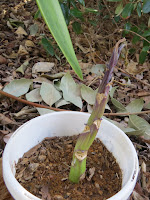Our neighbor got her garden up and running this past fall and it sure produced. Deane helped her build a large raised bed and after a couple of false starts it took off.
I need to do a post on the building of this bed for her.
She gifted us with some broccoli and I've been trying to think of something special to do with it and was checking recipe ideas for roasting when I came across a delicious sounding, no milk or cream, roasted broccoli soup.
Roasting always gives vegetables a great taste because it will lightly caramelize the sugars, and in the case of broccoli, tame some of the "mustard" notes.
I give you the original recipe below.
Broccoli was the only ingredient in the original recipe I had! Ha! I substituted type of potato, onion, cheese and acid, and added my own garnish.
So I improvised as I frequently do. We were really pleased with the way it turned out. Lighter because of no milk or cream, but the taste was rich, full and great. And I added a garnish of some of our sugar peas and sugar pea flower and also some Stock flowers. The Stock flower is an edible member of the broccoli family so I thought that was appropriate.
 |
| Sugar Peas with Flower |
Roasted Broccoli, Potato, Cheese Soup
Makes about 3-4 cups
Inspired by:
https://www.thekitchn.com/roasted-broccoli-amp-cheddar-soup-159133
2 tablespoons of avocado oil
1 medium size head of Broccoli
1 potato
4 ounces white American cheese
handful of I'iotoi Onion tops
2 cups of water
salt and cracked black pepper
limequat
An immersion blender works best for this, or you can use a counter blender working in batches and return to the pot to continue cooking.
 |
| Stock Flowers |
Cut broccoli up including stalks.
Clean and cut potato into about 1 inch chunks - I leave peels on
Snip onion tops
Shred or cube cheese and set aside
Cut up sugar pea for garnish into 1/2 inch pieces, set aside
Heat 1 tablespoon of oil in a medium size pot.
Spread broccoli in pan, sprinkle 1 tablespoon of oil over, season with some salt and cracked black pepper, stir and roast for 5 minutes.
While the broccoli is roasting add onion to hot oil in pot, stir and reduce heat and cook for about 5 minutes more, stirring as needed.
Add water and potatoes to pot bring to a boil, add a bit of salt, cover and cook at a low boil.
Stir broccoli and roast for 5 minutes more. When the broccoli is finished add to pot, keep at a low boil, cover and cook until all are tender - about 7 minutes.
Using the immersion blender puree. I like to leave some chunks in the soup.
Add cheese to melt, stirring into the soup to combine.
Serve with garnish of sugar peas and flowers. Squeeze a bit of lime juice over each bowl.
By the way, after trying several different methods of staking our sugarpeas we came up with a zig-zag bending of hogwire set up using a couple of bamboo poles for stability. We put the fence in AFTER the vines were already growing and it is working but it will work better next year when I put the fence up FIRST then sow. Also I did a denser sowing of the peas and the production shows the good result of this decision. I just sowed a few more to get me through spring. You can see the pretty pink/rose colored flowers of the sugarpea variety "Pea Magnolia Blossom Tendril". Love the color and the peas.
Our asparagus will be coming up in a few weeks and I think an asparagus, potato, cheese soup will be on the menu later on.
* If you have not taken my survey in the upper side bar, I sure would appreciate your input. Votes are anonymous and your preferences are important to me. Thank you. *
-- Catherine, The Herb Lady
If you enjoyed this post, subscribe below by entering your email, to get all my posts!
Disclaimer: Clicking on links on this blog may earn me a small commission if you purchase something. Your price does not change.



































